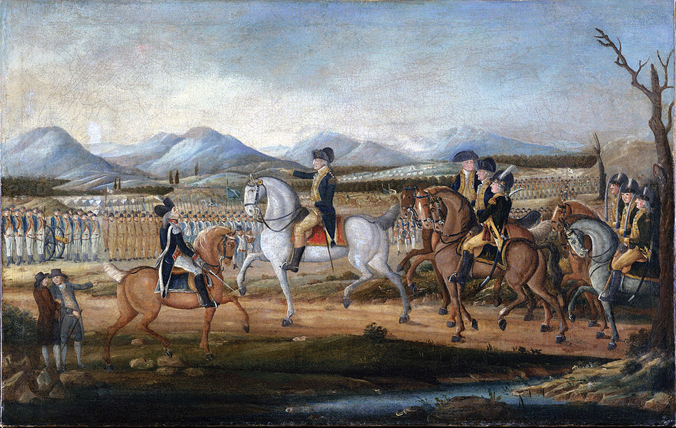Lawrence Lewis was born on April 4, 1767, the ninth child of Fielding and Betty Lewis and nephew of George Washington. His birth was noted by Fielding in the Lewis family bible,
“Our Ninth a Son named Lawrence born the 4th of April 1767. Mr. Chas Washington & Mr. Francis Thornton Godfather & Mrs. Mary Dick Godmother”[1]
Just as the American Revolution started, Lawrence moved into Kenmore with his parents and siblings when he was eight years old. Sadly, the move to the new house began a devastating chapter for the family that saw the loss of their financial security and, ultimately, of their patriarch. Lawrence witnessed the toll that financing and supporting the War for Independence exacted on his father. For the Patriot cause, Fielding provided much needed supplies to the army, bought and built ships for the navy, and funded a musket factory with his own money. After all these sacrifices, Fielding died in 1781 when Lawrence was fourteen.
Fielding bequeathed his ninth child “one thousand acres of land in the County of Frederick [this land was near Bath, Virginia, which is now Berkeley Springs, West Vriginia] on which my overseer Butler now lives as surveyed by Mr. Berry with the one sixth part of all my negroes.”
Instead of going west, however, Lawrence struck out east. By 1790, the twenty-three year old was living in Essex County and awaiting the birth of his first child with his wife Susannah Edmonton. Sadly, Susannah and the child died in labor. After this devastating death, Lawrence disappears from the historic records until four years later.
In 1794, Lawrence volunteered for military service and served as aide-de-camp to General Daniel Morgan in western Pennsylvania during the Whiskey Rebellion. [2] This rebellion was led by western farmers in response to the tax on all domestically-produced distilled spirits. This was the first time the newly formed government, under the leadership of Lawrence’s Uncle Washington, who was now President of the United States, imposed a tax on a domestic product. A destructive uprising was avoided and the tax was eventually repealed under Thomas Jefferson but the event led to the formation of America’s first political parties. [3][4][5]

President George Washington reviews troops near Fort Cumberland, Maryland, before their march to suppress the Whiskey Rebellion in western Pennsylvania. Unknown, attributed to Frederick Kemmelmeyer – Metropolitan Museum of Art. Public domain.
After Washington retired from the presidency, he began looking for a personal secretary and offered the position to Lawrence.
“I require some person (fit & Proper) to ease me of the trouble of entertaining company…and for a little time only, to come, an hour in the day, now and then, devoted to the recording of some Papers which time would not allow me to complete before I left Philadelphia.”[6]
Lawrence became part of the Washington household at Mount Vernon assisting his uncle with his entertaining, correspondence, and day-to-day activities. Also residing at Mount Vernon was Eleanor “Nelly” Parke Custis, the granddaughter of Martha. Eleanor and her brother George had been informally adopted by the Washingtons after the death of their father. Two years after arriving at his uncle’s house, Lawrence and Eleanor married on February 22, 1799.
Obviously fond of his nephew and step-granddaughter, Washington enjoyed having them near Mount Vernon. Shortly before his death, he offered Lawrence and Nelly a large tract of land. Washington made it known that he wanted them to start enjoying the property immediately and not wait for his death.
“But, as it has been understood from expressions occasionally dropped from your wife, that it is the wish of you both to settle in the neighborhood…I shall inform you, that in the will which I have by me …that part of my Mount Vernon tract…is bequeathed to you and her jointly, if you incline to build on it.”[7]
Sadly, George died a few months after he made the offer of land to the couple and never got to enjoy his nephew’s family living so near.
Lawrence and Eleanor started building their home, now known as Woodlawn, in 1800. The house was completed five years later and designed by William Thornton, the same architect who designed the U.S. Capitol. Owned by the National Trust for Historic Preservation in Alexandria, Virginia, you can visit Woodlawn as well as the 20th century Pope-Leighey House designed by Frank Lloyd Wright. The two houses provide a great juxtaposition between a classical Federal house of straight lines and proportion and a modern Usonian home that exudes simplicity and nature.[8] Lawrence and Nelly raised their eight children and lived peacefully at Woodlawn until 1830.
Lawrence Lewis died on November 20, 1839 at the age of 72 and was buried close to George and Martha in the vault at Mount Vernon. His wife Eleanor passed away in 1852 and was placed next to her husband and much loved adopted grandparents.
Heather Baldus
Collections Manager
[1] Felder, Paula. “Fielding Lewis and the Washington Family”, The American History Company, Fredericksburg, 1998, pg 73
[2] http://www.mountvernon.org/research-collections/digital-encyclopedia/article/lawrence-lewis/
[3] Holt, Wythe. “The Whiskey Rebellion of 1794: A Democratic Working-Class Insurrection”.
[4] http://historynewsnetwork.org/article/27341
[5] http://www.mountvernon.org/research-collections/digital-encyclopedia/article/whiskey-rebellion/
[6] “From George Washington to Lawrence Lewis, 4 August 1797,” Founders Online, National Archives (http://founders.archives.gov/documents/Washington/06-01-02-0245 [last update: 2015-03-20]). Source: The Papers of George Washington, Retirement Series, vol. 1, 4 March 1797 – 30 December 1797, ed. W. W. Abbot. Charlottesville: University Press of Virginia, 1998, pp. 288–289.
[7] “From George Washington to Lawrence Lewis, 20 September 1799,” Founders Online, National Archives (http://founders.archives.gov/documents/Washington/06-04-02-0263-0001 [last update: 2015-03-20]). Source: The Papers of George Washington, Retirement Series, vol. 4, 20 April 1799 – 13 December 1799, ed. W. W. Abbot. Charlottesville: University Press of Virginia, 1999, pp. 311–315.


